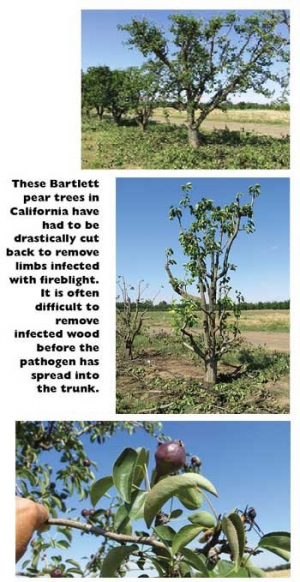The generally arid conditions in the Pacific Northwest limit the threat of the disease, which needs warm and moist conditions to become established. Some areas in the Midwest and eastern United States, which have more humid weather, simply can’t grow pears because of fireblight. Some varieties are more susceptible to the disease than others, but in general pears are more susceptible than apples.
Currently, the antibiotics oxytetracycline and streptomycin are growers’ first line of defense, but chances are they won’t be allowed in organic agriculture after October 2014. At its April 2013 meeting, the National Organic Standards Board rejected a petition to extend use of oxytetracyline for another two years. It is expected to reach a similar decision for streptomycin at its next meeting on October 22-24 in Louisville, Kentucky.
California has about 450 acres of organic pears, mainly in the central valley. Fireblight is a perennial problem because of the humid climate and long growing season, reports Rachel Elkins, University of California pomology farm advisor in Lake and Mendocino counties.
“I would say all of our organic growers in California are depending on antibiotics for fireblight control because we’ve got such vigorous growth,” she said, explaining that the disease spreads quickly in vigorously growing trees.
In Washington, growers can cut out diseased limbs to prevent the organism from spreading and killing the whole tree, but that’s more difficult when it spreads much faster, she added.
Also, whereas Washington conditions are not conducive to fireblight every season, California growers battle it year in year out.
Another difference is that the fungal disease scab rarely develops in Washington’s dry conditions, but it’s a common problem in California. Antibiotics for fireblight can be tank mixed with scab treatments, such as copper, dithane, or ziram, but biological fireblight controls can’t. That means an additional trip through the orchard.
“It’s whole different ball game in California than it is in the Northwest,” she said. “You do not see a pear industry except where they can manage fireblight. If you can’t manage fireblight, you’re out of business.”
Even in Washington, the Concorde pear, which is very sensitive to fireblight, is hardly produced any longer.
Elkins said that without antibiotics, the range of places where organic pears can be grown will be further limited.
“Like anything else, where you grow something becomes a competitive issue,” she said. “Where people can grow organics successfully, it will be done. Whether it’s going to be done on the same farms, by the same people, in the same manner—that may not stay the same.”


Leave A Comment